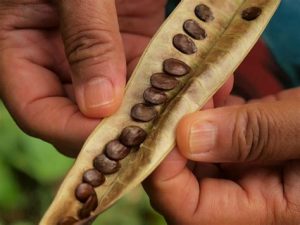
Saving seed and sharing seeds and knowledge through workshops and training is such a powerful to support colleagues and friends. Leucaena is a genus of flowering plants in the mimosoid clade of the subfamily Caesalpinioideae of the legume family Fabaceae. It contains about 24 species of trees and shrubs, which are commonly known as leadtrees. They are native to the Americas, ranging from Texas in the United States south to Peru.The generic name is derived from the Greek word λευκός (leukos), meaning “white,” referring to the flowers.
Leucaena is a genus of flowering plants in the mimosoid clade of the subfamily Caesalpinioideae of the legume family Fabaceae. It contains about 24 species of trees and shrubs, which are commonly known as leadtrees. They are native to the Americas, ranging from Texas in the United States south to Peru.The generic name is derived from the Greek word λευκός (leukos), meaning “white,” referring to the flowers.
During the 1970s and 1980s, it was promoted as a “miracle tree” for its multiple uses. It has also been described as a “conflict tree” because it is used for forage production but spreads like a weed in some places.
The legume is promoted in several countries of Southeast Asia (at least Burma, Cambodia, Laos, and Thailand), most importantly as a source of quality animal feed, but also for residual use for firewood or charcoal production.
Green manure and biomass production
Leucaena leucocephala has been considered for biomass production because its reported yield of foliage corresponds to a dried mass of 2,000–20,000 kg/ha/year, and that of wood 30–40 m³/ha/year, with up to twice those amounts in favorable climates. In India it is being promoted for both fodder and energy.
It is also efficient in nitrogen fixation, at more than 500 kg/ha/year.
It has a very fast growth rate: young trees reach a height of more than 20 ft in two to three years.
Above from Wikipedia.
It is these fast growing and nitrogen fixing properties which have caught the attention of permaculturalists as it can be a very useful for regenerating degraded land. There are a couple of dangers, it can be invasive, it is a fast growing pioneer tree, which produces a lot of seed, so it can spread fast and can be unwanted, but managed and harvested it produces a great deal of biomass and builds soil
Some species of Leucaena can be toxic to non-ruminant animals like hoses and donkeys, but in general it is a very versatile and useful plant


Ali Tebandeke is a valued member of the S39 team and is a permaculture ambassador. Here he is South Africa where he has been in Jo’berg and Limpopo sharing his knowledge and enthusiasm for permaculture, including sharing seeds and knowledge with with his peers. Above are Leucaena seeds brought from a training session in Eastern Uganda to South Africa to assist in land restoration projects he is engaged in there







You must be logged in to post a comment.